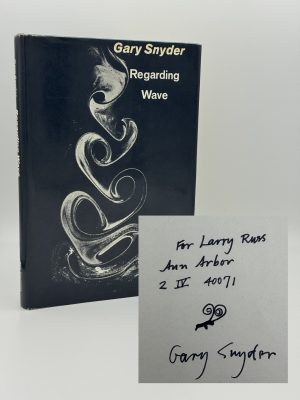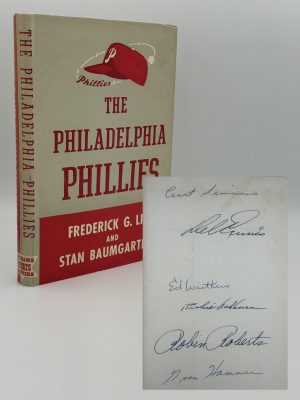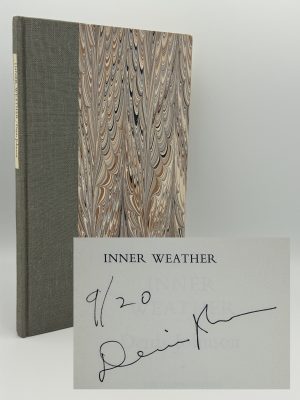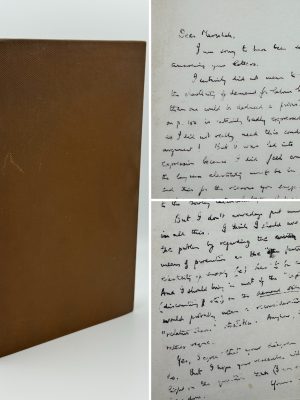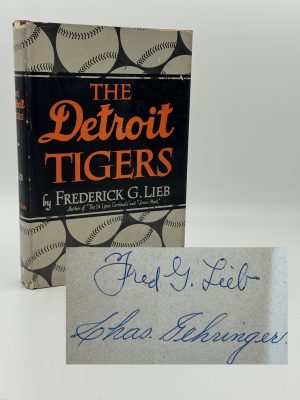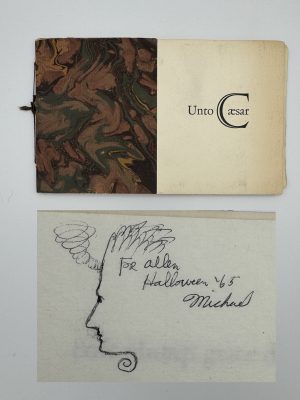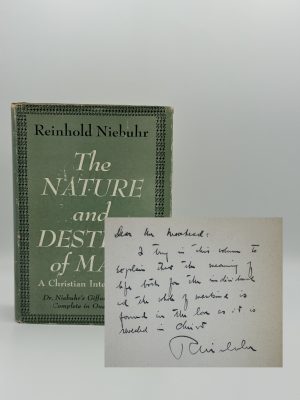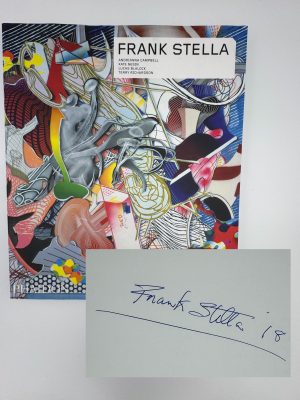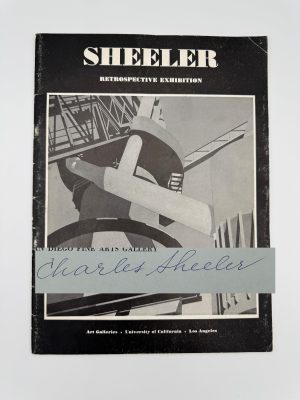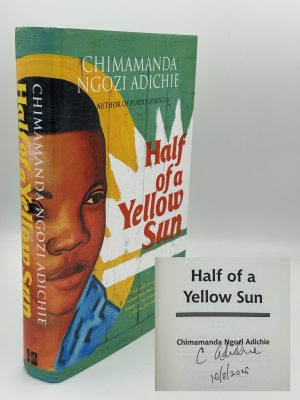-
Snyder, Gary
Regarding Wave
$350.00New Directions: New York, 1970. First edition. Signed, located and dated in the year following publication, inscribed to the leader of the student-run Writer in Residence program at University of Michigan at Ann Arbor. Snyder has also added an original drawing of a small animal. Offsetting from laid in newsprint to title and opposite page, scant edgewear to spine tips, small spot top front board, otherwise a fine, tight and unread copy in fine, priced dust wrapper. A very fresh copy. less
moreOffered for Sale by: The Accidental Bookseller -
Lieb, Frederick G. and Baumgartner, Stan
The Philadelphia Phillies.
$500.00G. P. Putnam’s Sons: New York (1953). First edition. Part of the “Putnam Sports Series”. Signed by six members of the “Whiz Kids”, the 1950 Phillies team which, despite a number of young players, unexpectedly won the National League pennant before losing the World Series to the Yankees. Players and their 1950 statistics are: Robin Roberts, elected to the Hall of Fame in 1976, winner of 20-games with a 3.02 ERA Richie Ashburn, Hall of Fame Center Fielder and two-time National League batting leader, hit .303 Del Ennis, Right Fielder who had more RBI than any player other than Stan Musial from 1949-1957, led the team with a .311 batting average, 31 home runs and 126 RBI Curt Simmons, starting pitcher who went 17-8 with a 3.40 ERA Eddie Waitkus, starting First Baseman, .284 batting average Granny Hamner, .starting Shortstop, 270 batting average, 70 RBI Mild toning to endpapers and pastedowns, a solid near fine copy in like dust wrapper less
moreOffered for Sale by: The Accidental Bookseller -
Johnson, Denis
Inner Weather
$1,250.00Port Townsend: Graywolf Press, (1976). First Edition. Limited edition, #9 of only 20 copies, signed by Johnson. The very scarce hardbound edition, simultaneously issued with 600 unsigned copies in wrappers. Johnson’s second book of poetry, published seven years before his first novel. An early publication from the author of Jesus’ Son and the National Book Award winning Tree of Smoke. Nearly fine with slight softening to corners without dust wrapper as issued. less
moreOffered for Sale by: The Accidental Bookseller -
Hicks, J. R.
The Theory of Wages
$6,750.00London: Macmillan & Company, 1932. First edition of Hicks’ first book, an attempt at a careful and complete restatement of the marginal productivity theory. In the book, Hicks developed the microeconomics of wage determination in competitive and regulated labor markets. This work also introduced the famous concept of “elasticity of substitution” between capital and labor, which became his basis to dispute Karl Marx’s theory by arguing that labor-saving technological progress does not necessarily reduce labor’s share of income. The book became a standard textbook on labor economics for decades. Pasted in to rear is an autograph letter signed by Hicks to fellow economist Jacob Marschak. Circa 250 words over two-pages. Dear Marschak, I am sorry to have been so long before answering your letters. I certainly did not mean to imply that the elasticity of demand for labour being greater than one would be deemed a priori. The note on p. 100 is certainly badly expressed, especially as I did not really need this condition for my argument! But I was led into certain expression because I did feel convinced that the long run elasticity must be in fact > 1; and this for the reasons you suspect. I could not believe that the elasticity of supply of the other factors (long-period elasticities gains) were likely to be very negative – I should on the whole expect that their curves won’t be far from zero; and if this is so, the <mathematical expression> formula gives what seems a quite impossibly low value for σ if λ < 1. (This with a view to the Bowley calculation.) But I don’t nowadays put much confidence in all this. I think I should now approach the problem by regarding the <illegible> non-labour means of production as the “<illegible> factors whose elasticity of supply (ε), has to be considered. And I should bring in most of the “capital” complications (discovery, etc.) on the demand side. But this would probably mean a reconsideration of the “relative share” statistics. Anyway it is all rather vague. Yes, I agree that your diagram will <illegible> do. But I hope your research will throw more light on the question than (I am sure) mine has done. Autographed material from John Hicks is quite rare, and none of his letters, and few signed books, appear in book auction records. A very good copy lacking the scarce dust wrapper, spine tips rubbed, foxing to side of text block, weakness to the hinge between pages 96 & 97, and bookseller’s label from B. H. Blackwell of Oxford (Marschak, it should be noted, held positions at Oxford from 1930 – 1939). John R. Hicks received the Nobel Memorial Prize in Economic Sciences (jointly with Kenneth J. Arrow) in 1972 for his pioneering contributions to general equilibrium theory and welfare theory. One of the most important and influential economists of the twentieth century, the trail of the eternally eclectic John Richard Hicks is found all over economic theory. Hicks made major contributions to many areas of 20th-century economics; four, in particular, stand out. First, he showed that, contrary to what Karl Marx had believed, labor-saving technological progress does not necessarily reduce labor’s share of the income. Second, he devised a diagram—the IS-LM diagram—that graphically depicts John M. Keynes’s conclusion that an economy can be in equilibrium with less-than-full employment. Third, through his book Value and Capital (1939), Hicks showed that much of what economists believe about value theory (the theory about why goods have value) can be reached without the assumption that utility is measurable. Fourth, he came up with a way to judge the impact of changes in government policy. He proposed a compensation test that could compare the losses for the losers with the gains for the winners. If those who gain could, in principle, compensate those who lose—even if they do not actually and directly compensate them—then, claimed Hicks, the change in policy would be efficient. “How is one to assess an economist whose legacy runs as wide and deep as that of John Hicks? The quintessential ‘economist’s economist’, Hicks cannot be said to have founded a ‘school’ – unless one were to count the generation of eclectic and critical Neo-Walrasian theorists inspired by his visionary but careful work, such as Morishima, Hahn and Negishi. But Hicks was for the most part a lone thinker, part of every school and thus part of no school. If any, his school was ‘economics’. Hicks himself claimed to have created no new economics but simply to have spent his life understanding, formulating and channeling the ideas of the Continental and Keynesian schools and his own historical, philosophical and practical reflections. In a sense, he may have been right – but he analyzed and extended them in a meaningful and challenging way and thus transformed economics in the process. In many ways, Hicks’s scholarly output is a perfect demonstration of how economics should be done: without partisanship for pet theories, without ideological quibbling, his own strictest critic, learning from all and everywhere, constantly searching for new ideas and staying glued to none. Hicks’s approach to economics was informed by all the best qualities of the scientist, poet, philosopher and practical man, and he let none of these tendencies overreach themselves and overwhelm any other. In this sense, no economist before or since Hicks, has achieved such ‘Olympian’ scholarship.” (The History of Economic Thought) The book is annotated in pencil, presumably by Marschak, with the summary “Assuming truth’s and half-truth’s with equal self confidence” written to the front free end paper. Jacob Marschak was an “important developer of economics information theory and a contributor to the early study of econometrics…Marschak’s major work was done in an obscure but important area of conceptual economic theory helping develop methodology for mathematical problem solving” (NY Times obituary). Not mentioned – because not known at the time – is that three of Marschak’s doctoral students went on to win the Nobel Prize for Economics: Leonid Hurwicz (2007), Harry Markowitz (1990) and Franco Modigliani (1985). Marschak was impressed by the need for quantification of economics. His 1931 paper on the elasticity of demand was a landmark in econometric analysis, and as head of the Cowles Commission from 1943 – 1948, Marschak can be given credit for getting the ball rolling for the development of Neo-Walrasian economics and econometrics in the post-war era. Marschak’s contributions to economic theory in this phase were dominated by his interest in the concept of uncertainty. Already in his classic 1938 papers (one with Helen Makower) on monetary theory, Marschak set down the basic ideas for portfolio theory, in which risk was acknowledged to play a role. His encounter with the work of John von Nemann and Oskar Morgenstern (1944) led him to write his famous 1950 exposition of the axiomatization of choice under uncertainty, when he introduced the infamous “independence axiom”. It was specifically in the theory of information, the theory of “teams” and decentralized organizations where Marschak was to make his name (1954, 1968, 1971, 1972). He is renowned for having developed the theory of stochastic design as a way of statistically measuring demand. It was Marschak who helped introduce modern information theory into economics via Shannon’s formalization of information via the mathematical theory of communication. Kenneth J. Arrow, himself a Nobelist, wrote “Marschak became a leader of research organizations at a relatively young age in Germany, and later—with his increasing recognition—was director of the Oxford Institute of Statistics (1935-1939) and of the Cowles Commission for Research in Economics at The University of Chicago (1943-1948)—a fertile period that greatly influenced the course of economic analysis in several diverse fields. Only after 1948 did he begin to make the contributions to economic analysis that are most distinctively his own. Yet in curious ways, the subject matter of his later studies was consonant with his earlier career. An organizer of economic research, he became a theorist of organization. A student and critic of new developments in economic analysis, he developed the economics of information. A skeptic distrustful of received dogma, he studied the economics of uncertainty. Another characteristic of Marschak’s work was his consistently interdisciplinary approach. Some of his early papers dealt with class structure and the emerging phenomenon of Italian fascism. From 1928 to about 1953, though his titles stayed more narrowly within the field of economics as it was then understood, the papers themselves not infrequently contained broader notions derived from politics, sociology, and—later—individual psychology. His work on information and organization, for example, led to a series of experimental and theoretical studies on the psychology of decision making, while during his last fifteen years he organized an interdisciplinary behavioral sciences seminar that proved a main source of contact among mathematical modelers with widely divergent interests.” less
moreOffered for Sale by: The Accidental Bookseller -
(Gehringer, Charles) Lieb, Fredrick G.
The Detroit Tigers
$400.00G. P. Putnam’s Sons: New York (1946). Presumed first edition (no other printings indicated). Part of the “Putnam Sports Series”. Signed by the author, a Hall of Fame sportswriter inducted into Cooperstown in 1973. Also signed by Charles (“Chas”) Gehringer, Hall of Fame Tigers second baseman from 1924 – 1942. A lifetime .320 hitter with over 2,800 hits, Gehringer was one of the best fielding second baseman in the history of the game. At the time of his retirement, he owned the MLB record for double plays turned by a second baseman and remains among the all-time MLB leaders in assists and putouts. Lieb spent nearly 70 years as a sportswriter and is credited with coining the term “The House that Ruth Built,” referring to the New York Yankees’ brand new stadium. Over his career, he covered every World Series game from 1911 to 1958, 30 All-Star games, and over 8,000 major-league baseball games. Newsprint offset front pastedown and free end paper, little toning to rear free end paper, unobtrusive mark to front board, otherwise a bright, fresh and nearly fine copy in very good dust wrapper, corners clipped, slightly chipped at spine ends, rubbed along sides spine. less
moreOffered for Sale by: The Accidental Bookseller -
McClure, Michael
Unto Caesar
$450.00(San Francisco): (Dave Haselwood), (1965). A non-commercial publication, with most copies given away to friends of the author and printer. Hand-sewn in printed wrappers, 6.5″ x 4″, 24 pages, circa 60 copies. The first publication from Dave Haselwood after he left Auerhahn Press in the hands of his partner, Andrew Hoyem. This copy inscribed “For Allen”, signed “Michael”, and dated Halloween, 1965. Additionally, McClure has added a self-portrait drawing. Although not definitively established, it seems likely that the recipient is Allen Ginsberg. Ginsberg and McClure both lived in San Francisco at the time, and the famous photograph of them with Bob Dylan and Robbie Robertson in the alley behind City Lights Books was taken shortly after the date of the inscription. A very good copy, front wrap unevenly and lightly tanned, rear wrap with one light crease, spine a little rubbed, some interior pages don’t quite align to wraps (potentially as issued). less
moreOffered for Sale by: The Accidental Bookseller -
Niebuhr, Reinhold
The Nature and Destiny of Man
$600.00New York: Charles Scribner’s Sons, 1949. First one volume edition. Signed and inscribed by Niebuhr, adding “I try in this volume to explain that the meaning of life for the individual and the whole of mankind is found in the love as it is revealed in Christ.” An important and revealing copy of this landmark of twentieth-century thought. Exploring the complexities of human nature and the philosophical and theological implications of humanity’s existence, the Nature and Destiny of Man was rated number 18 of the Modern Library’s Top 100 Nonfiction works in the 20th century. “A collection of theological lectures delivered by Niebuhr in 1939, The Nature and Destiny of Man tackles the Christian concept of human nature, the powerlessness of man, and Christianity’s impact on human history. Delivered just before the outbreak of World War II, these lectures were so influential that Cold War containment policies and aspects of realpolitik can be traced back to them. Highly recommended for fans of ontology.” less
moreOffered for Sale by: The Accidental Bookseller -
Sheeler, Charles
A Retrospective Exhibition 1954
$400.00Art Galleries, University of California Los Angeles (UCLA): 1954. Foreword by William Carlos Williams. Signed boldly by Sheeler and scarce thus, as Sheeler’s signature is quite uncommon. Few creases, wear to spine, some loss of color. Overall, very good in wrappers. Sheeler was a leading exponent of the innovative modernist style that arose after World War I in the United States and came to be known as Precisionism. Artists associated with the movement fused a planar geometry developed from European Cubism with an interest in uniquely American subjects, often celebrating industry and a Machine Age aesthetic. Sheeler worked across artistic mediums and developed a versatile, complex practice in which his vision was expressed with equal artistic command and intellectual rigor, masterfully devising compositions of modern, geometric form from America’s burgeoning urban and industrial landscapes. (source: The Whitney Museum). less
moreOffered for Sale by: The Accidental Bookseller -
Adichie, Chimamanda Ngozi
Half of a Yellow Sun
$400.00Fourth Estate, London, 2006. First U.K. edition and true first. Winner of the Orange Broadband Prize for Fiction 2007, awarded annually to a female author of any nationality for the best original full-length novel written in English, and named the “Best of the Best” of the Women’s Prize for Fiction (formerly known as the Orange Prize and Baileys Women’s Prize) in 2020, recognizing it as the best book to have won the prize in its 25-year history. Signed by the author and dated five days prior to the official publication date. Fine in fine dust wrapper, lightly crinkled at the spine tips. less
moreOffered for Sale by: The Accidental Bookseller -
Penrose, Roger
Fashion, Faith, and Fantasy in the New Physics of the Universe
$500.00Offered for Sale by: The Accidental Bookseller -
Hawkes, John (Author); Solien, T. L. (Artist).
Innocence in Extremis
$500.00New York: The Grenfell Press, 1985. From the colophon: “118 copies have been printed & published at The Grenfell Press, New York City, in spring/summer 1985. Copies numbered 1-85 are printed on Saunders paper and bound in quarter morocco with the covers and frontispiece by T. L. Solien. Roman numeral copies I-XV are bound in full morocco hand-colored by the artist and contain a frontispiece. Lettered copies A-R are for the author and artist. Bindings are by Claudia Cohen; Michael Bixler has set the text in Dante. Each copy has been signed by John Hawkes and T. L. Solien.” Copy XIII of the Roman numeral edition. T. L. Solien’s work has been the subject of numerous exhibitions across the country and is included in public and private collections around the world. Selected collections include: Metropolitan Museum of Art, Whitney Museum of American Art; Smithsonian American Art Museum; Art Institute of Chicago; Milwaukee Art Museum; Madison Museum of Contemporary Art; Minneapolis Institute of Art; Tate Gallery, London; National Gallery of Australia; Singapore Art Museum, among others. (source: Tory Folliard Gallery). Near fine, slight uneven tanning to boards, small and shallow abrasion to rear cover. In publisher’s plexiglass slipcase, one seam split as appears to be common to be this title, small chip and a couple of cracks, neither affecting the case’s integrity. less
moreOffered for Sale by: The Accidental Bookseller

 USD
USD GBP
GBP EUR
EUR CAD
CAD AUD
AUD ZAR
ZAR